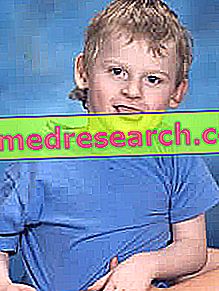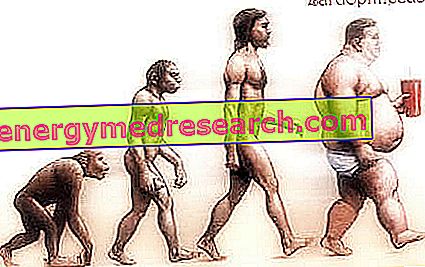Generality
Angelman syndrome is a rare genetic neurological disease caused by a mutation of the maternal chromosome 15. It manifests itself with severe intellectual, behavioral and motor deficits; the patient shows the first symptoms already in early childhood, but the parents are not always able to notice it immediately.

Figure: a child with Angelman syndrome. From the site: armyofangels.org
At the first suspicions of something abnormal, it is therefore good to subject the small patient to some genetic tests, which are able to clarify the situation.
Unfortunately, Angelman syndrome is incurable, but there are good countermeasures that relieve symptoms and improve the standard of living of patients.
Brief reminder of genetics: DNA and chromosomes
Before describing Angelman syndrome, it is good to make a brief reference to genetics.
CHROMOSOMES AND DNA
Every cell of a healthy human being has 23 pairs of homologous chromosomes : 23 are maternal, that is, inherited from the mother, and 23 are paternal, or inherited from the father. A pair of these chromosomes is sexual, that is, it determines the sex of the individual; the remaining 22 pairs, instead, are composed of autosomal chromosomes . In their entirety, the 46 human chromosomes contain the entire genetic material, better known as DNA .
In the DNA of an individual are written his somatic traits, his predispositions, his physical abilities etc.
GENES AND MUTATIONS OF DNA
DNA is organized in many sequences, more or less long, called genes .

Figure: the organization of a gene within a pair of homologous chromosomes. A pair of homologous chromosomes contains specific genes, all having two variants, the alleles, occupying the same chromosomal position and doing the same functions (except mutations). The left pair of chromosomes has two equal alleles (both blue); the right pair instead has two different alleles (one is red, the other is blue).
Each gene occupies a specific chromosome and its counterpart, as it is present in two copies, called alleles . An allele comes from the mother and resides in the maternal chromosome; the other allele comes from the father and is housed in the paternal chromosome.
From the genes the proteins originate, present in our body. When a DNA mutation occurs, a gene (usually only one allele) of a given chromosome can be defective and consequently produce a defective protein, or fail altogether.
What is Angelman syndrome
Angelman syndrome is a genetic disease that affects the nervous system and causes physical-motor and intellectual deficits. Individuals with Angelman syndrome experience the first ailments shortly after birth; in general, it is the parents who notice it and notice a delay in development.
Life expectancy is more or less that of a healthy person, but, with this exception, there are no other similarities: the patient, in fact, is clearly affected by various disabilities and abnormal behaviors.
Epidemiology
Angelman syndrome is very rare: it affects one person every 25, 000. The first signs of the disease are around 6-12 months of life, but, often, the diagnosis is much later, between 2 and 6 years.
Causes
Angelman syndrome is a genetic disease. Therefore, the triggering cause is an anomaly, or mutation, of a gene.
The gene in question is the so-called UBE3A, located on chromosome 15 .
THE ALLELI OF THE GENE UBE3A
Usually, our body's cells use both alleles to create proteins. In other words, this means that both chromosomes, maternal and paternal, are useful and provide their genetic contribution.
However, in some particular cells, due to an evolutionary and non-pathological issue, only one (paternal or maternal) allele works and its work is more than satisfactory.
The UBE3A gene is present in all cells of the human body. Like any gene, it is composed of two alleles, one maternal and one paternal, equally functioning, except in the brain.

Figure: a chromosome 15 and the position of the UBE3A gene. From the site: cureangelman.org
In fact, in some brain cells, the only UBE3A active alleles are maternal ones.
THE GENE UBE3A AND THE ANGELMAN SYNDROME
Through genetic testing, it has been shown that patients with Angelman syndrome either have a mutation on the maternal chromosome 15, at the level of the UBE3A gene, or do not present it at all. These two possible alterations create less problems in the cells in which both alleles are active; on the contrary, they are deleterious in the brain, where the only active alleles are maternal ones.
GENETIC AND HEREDITARY? OR ONLY GENETICS?
Geneticists consider Angelman syndrome a genetic disease, since, from the studies carried out, it emerged that the genetic mutation is not inherited from the parents (who possess a normal chromosomal outfit), but arises shortly before conception.
However, the veracity of this statement is undermined by the detection of some pairs of parents with more than one child affected by Angelman syndrome. In these cases, there is reason to believe that there may be some hereditary component, still to be demonstrated, at the origin of the disease.
Symptoms and Complications
The typical symptoms and signs of Angelman syndrome are very numerous.
The deficits originate in the nervous system and manifest themselves at the physical-motor and intellectual level.
Despite being a disease present from birth, it is not easy to immediately notice its presence. In fact, delayed development (the most characteristic sign of childhood), during the first 6-12 months of life, can go unnoticed, only to become obvious later (18 months).
THE MAIN SYMPTOMOLOGY
The main symptomatology includes symptoms and obvious signs at the anatomic, motor, and behavioral level :
- Delayed development. After 6-12 months of life, the child does not make any sound and does not walk on all fours yet
- Intellectual deficits
- Complete or partial absence of the word
- Balance problems and lack of motor coordination ( ataxia )
- Flickering movement of arms and legs
- Frequent smiles and laughter, for no particular reason
- Excitable personality, agitation and inexplicable happiness
- Small and flattened head in the back
THE OTHER SYMPTOMS
Other verifiable characteristics, albeit to a lesser extent, are:
Behavioral / motor characteristics:
| Physical characteristics:
|
WHEN REFER TO A DOCTOR?
A child who is delayed in development during the first 6-12 months of life must be placed under medical observation, as it is not a customary fact. This indication applies in general, regardless of whether the origin of the disorder is Angelman syndrome or another disorder. It will be the pediatrician's task, after having subjected the child to the appropriate diagnostic tests, to establish what it is.
COMPLICATIONS
Angelman syndrome can be associated with other pathological conditions, sometimes even serious ones. Thanks to an early diagnosis of the disease, it is possible, at least in part, to remedy it.
- Difficulty eating . Some patients, in infancy (especially infants), can show serious difficulties in eating: sucking and swallowing are in fact altered.
- Hyperactivity . Many young patients with Angelman syndrome are hyperactive, ie they often change activity, moving from one to the other for no reason. Often, they associate some unusual gestures with this unusual behavior, such as clapping and grimacing with the mouth. Their attention span is also significantly reduced. Spontaneous improvements with age are observed.
- Sleep disorders . Patients sleep less and, when they do, have a disturbed sleep.
- Scoliosis . In some cases, abnormal spinal curvature and consequent scoliosis diagnosis may occur.
- Obesity . The patient tends to always have a lot of appetite, which leads him to accumulate many extra pounds.
Diagnosis
A pre-diagnosis of Angelman syndrome can be made from the physical examination of symptoms and signs. Then, for a confirmation, more or less specific genetic tests are needed.
EXAMINATION OBJECTIVE
During the physical examination, the pediatrician must determine whether the delayed development is pathological or not. After that, observe the patient's behavior, motor skills and physical appearance: lack of balance, small head, flattened skull and frequent laughter are important elements.
Very often, the doctor, given the young age of the patients, avails himself of the help of family members, who, spending a lot of time together with the patient, can provide valuable information regarding the various intellectual deficits etc.
GENETIC TESTS
Genetic tests definitively sanction pre-diagnosis, because they confirm whether or not it is Angelman syndrome. These tests are performed on a blood sample, so a small sample from the child under observation is sufficient.
The procedures are:
- Karyotype . Through it, we examine the chromosomal outfit of an individual, showing the shape, size and number of chromosomes present in his cells.
- Fluorescent in situ hybridization ( FISH ). It is a test that shows if parts of the chromosome are missing.
- DNA methylation . It is a conceptually very complex procedure. Through it, it is found whether the maternal chromosome 15 (containing one of the two alleles of the UBE3A gene) is missing or not. It is considered negative if the maternal chromosome 15 is present.
- Search for genetic mutations . It is an alternative test to DNA methylation, when it gives negative results (ie the UBE3A gene is there), but all the symptoms are, however, in support of Angelman syndrome. In fact, the UBE3A gene may be present but mutated.
Treatment
Unfortunately, since it is a genetic disease, Angelman syndrome is not curable. The only therapeutic treatments applicable are aimed at moderating symptoms (for example, epilepsy), limiting some abnormal behaviors and, in general, improving patients' standard of living.
To do this, you need a team of doctors and experts, specializing in different fields, from neurology to speech therapy, from physiotherapy to psychotherapy.
In the following, some of the most adopted therapeutic measures will be reported when one encounters patients with Angelman syndrome
HOW TO TREAT EPILESSIA
An individual with Angelman syndrome may suffer from epilepsy . In these cases, it is good practice to administer anti-epileptic drugs, against possible attacks.
PHYSIOTHERAPY AND OCCUPATIONAL THERAPY
Every patient has severe motor deficits and, for this reason, he needs to rely on an experienced physiotherapist who knows the basic pathology thoroughly. Accurate physiotherapy limits the lack of coordination, shaking of the limbs and prevents scoliosis. The improvements can be really obvious.
In addition to physiotherapy, occupational therapy is equally important. Through it, the patient is taught how to take care of himself, how to dress, how to eat, in other words how to carry out the main daily activities.
FEED DURING CHILDHOOD
During the first years of childhood, the sick child has considerable difficulty eating and swallowing food. Suction, for example, is almost impossible. To remedy this problem, a small nasogastric tube is used, through which the food flows (usually rich in nutrients and very caloric, to limit the use of the tube itself).
LANGUAGE THERAPY
Almost all patients have enormous communication problems, in the sense that they do not speak or speak few words. The intervention of a speech therapist, but also of an expert in sign language and graphics (via drawings) is fundamental.
PSYCHOTHERAPY
Although not all patients show the same degree of lack of attention, hyperactivity and sleep disorders, psychotherapy is always of fundamental importance. Indeed, it improves the patient's standard of living and the relationships between the latter and the rest of the people.
THE SUPPORT OF FAMILIES
The closeness of family members is essential to help the sick relative, especially when he is still young. The advice that is usually given to families is to follow the patient in all his activities, to find out about the right behavior to adopt against him, not to exclude him etc.
Prognosis and prevention
Since there is no specific cure for Angelman syndrome, the prognosis can only be negative. This also applies despite the fact that a patient's life expectancy is the same as a healthy person.
The few treatments available and the support that can be given through physiotherapy, psychotherapy, etc., improve the standard of living, even in a sensitive way, but there are still measures of symptom control and nothing more.
The support of family members is fundamental: their support, in fact, offers unthinkable benefits.
PREVENTION
Preventing Angelman syndrome is not easy, as this is not really an inherited disease. However, if two parents have given birth to a child with Angelman syndrome, before a second pregnancy they can undergo some genetic tests to find out whether they are carriers of the disease or not.



